Arizona Black Rattlesnake
Crotalus cerberus
Female Arizona black rattlesnakes sometimes share parenting duties.
Advertisement
Arizona Black Rattlesnake Scientific Classification
- Kingdom
- Animalia
- Phylum
- Chordata
- Class
- Reptilia
- Order
- Squamata
- Family
- Viperidae
- Genus
- Crotalus
- Scientific Name
- Crotalus cerberus
Read our Complete Guide to Classification of Animals.
Arizona Black Rattlesnake Conservation Status
Arizona Black Rattlesnake Facts
- Prey
- Lizards, amphibians, small mammals, and occasionally birds
- Name Of Young
- Neonate
- Group Behavior
- Semi-social
- Community-minded
- Fun Fact
- Female Arizona black rattlesnakes sometimes share parenting duties.
- Other Name(s)
- Arizona black rattlesnake, black rattlesnake, black diamond rattlesnake, brown rattlesnake, Cerberus rattlesnake, mountain diamond-back; often mistakenly called a timber rattlesnake
- Temperament
- Docile
- Litter Size
- 4-10
- Habitat
- Forests, leaf litter
- Diet for this Fish
- Carnivore
- Lifestyle
- Diurnal
- Solitary
- Sociable
- or Nocturnal Depending on Region and Season
- Favorite Food
- Small mammals
View all of the Arizona Black Rattlesnake images!
The Arizona black rattlesnake was the first rattlesnake seen interacting socially with other rattlesnakes.
This venomous snake is usually between two and four feet long. The adults are dark brown to almost black, and juveniles are more brightly patterned. They live in the forests of Arizona and western New Mexico at altitudes above 4,000 feet.
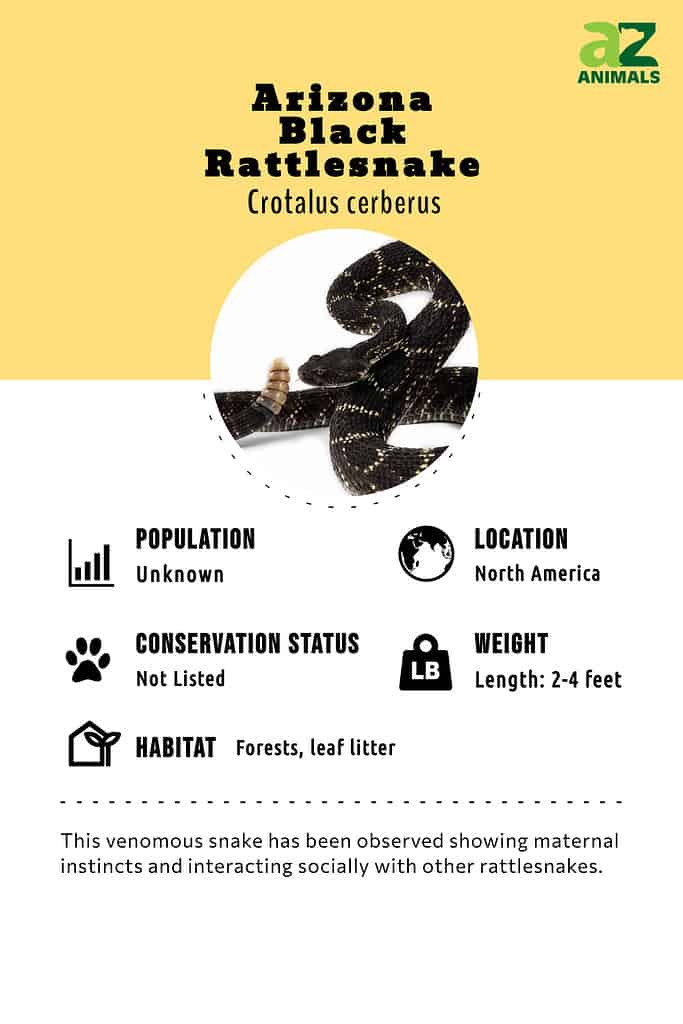
©
3 Amazing Facts About Arizona Black Rattlesnakes
- These snakes are social, and each individual seeks out their preferred community size; some in larger communities, some in smaller communities, and others spend most of their lives solo.
- They can change color! Arizona black rattlesnakes change colors depending on their mood.
- Females may birth their brood together and stay with each other until the neonates leave the nest.
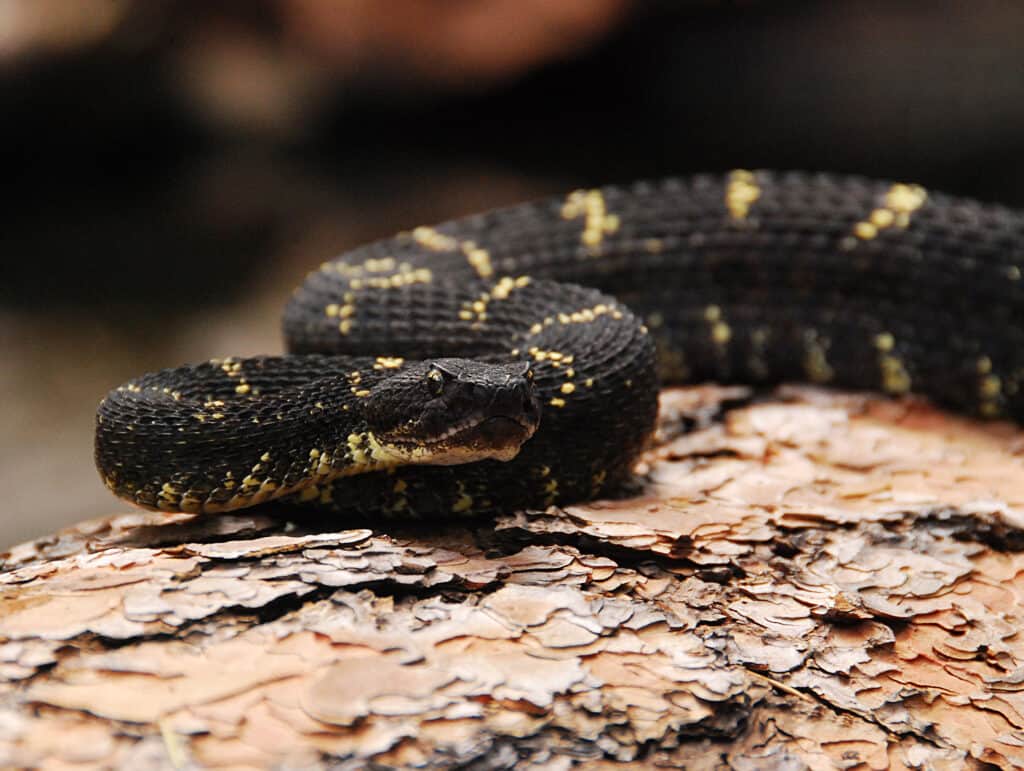
©jokerbethyname/Shutterstock.com
Where to Find Arizona Black Rattlesnakes
Arizona black rattlesnakes live at high altitudes in heavily forested areas of Arizona and western New Mexico. They thrive in cooler, moister conditions that the forests offer.
They are often coiled up in leaf litter or under rocks, waiting for a meal to stumble near enough to strike. Many people say that they look like cow pies until they get close enough to spot their rattles and pitviper heads.
These snakes are most active from late March to late October. They retreat to a communal den to hibernate between late October and early March. Each year, they return to the same den, with young and mature snakes sharing hibernation space.
Arizona black rattlesnakes appear to have some maternal instincts. As with other pit vipers, females stay with their young after birth for seven to 14 days or until their first shed. Scientists say that females sometimes cooperatively parent their young.
A group of researchers discovered this for themselves when they began photographing a female and her brood in Arizona. A typically passive female, this snake “Poked her head out of her shelter and then proceeded to crawl from her refuge toward us, still rattling, and glaring directly at us. Our once-placid Woody was now fearless and wanted us to know she would not tolerate our advance.”
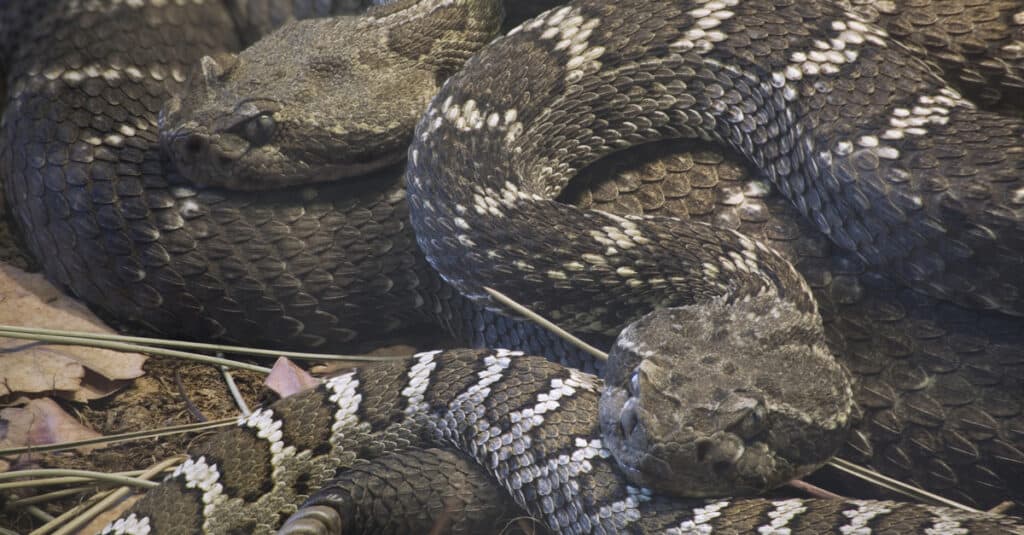
Arizona black rattlesnakes share communal dens, and females may share parenting duties.
©Dario Sabljak/Shutterstock.com
Scientific Name
The Arizona black rattlesnake’s scientific name is Crotalus cerberus, with its genus name describing its rattle (Crotalus). The specific epithet, cerberus, means spotted and originates in Greek with Kerberos. In Greek mythology, Cerberus was the three-headed guardian of the Underworld. In 1875, Elliot Coues described it as “Particularly repulsive due to the great size to which it attains, the caliber of the body, and the black color.” Coues called it the black rattlesnake, and the name stuck.
It is endemic to Arizona and far western New Mexico, so it’s commonly called the Arizona black rattlesnake. Although many people also call it a timber rattlesnake because of where it lives, this isn’t the timber rattlesnake of central and eastern United States. That is a different species: Crotalus horridus.
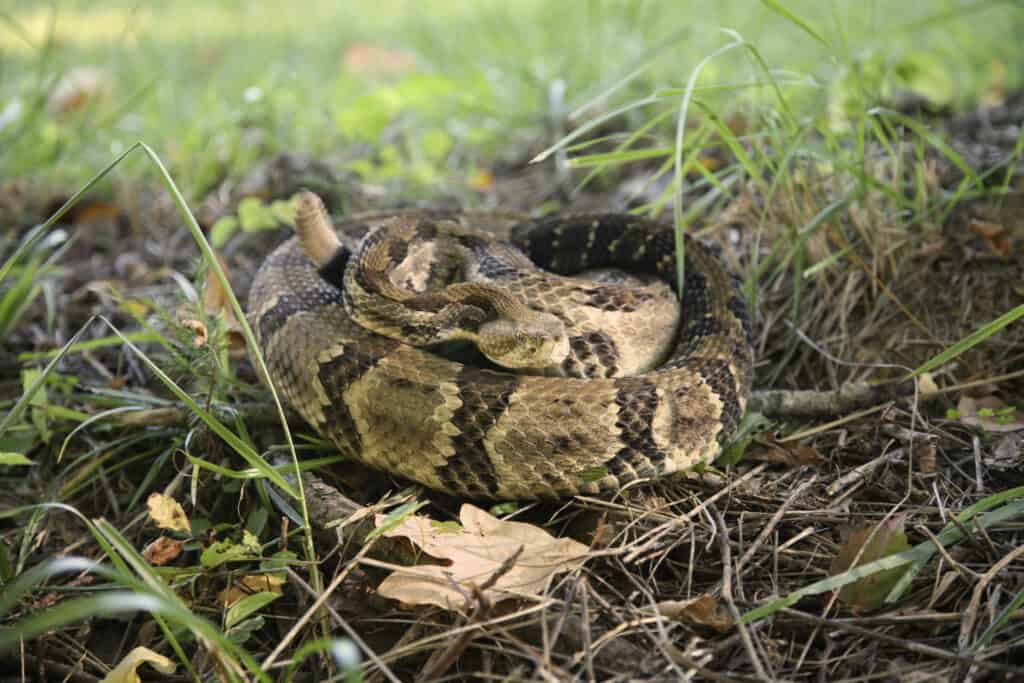
The Arizona black rattlesnake is mistaken by some for the timber rattlesnake, above, because of where they live.
©iStock.com/NajaShots
Evolution and History
The Arizona black rattlesnake is a member of the Crotalus genus of venomous pit vipers in the family Viperidae, which scientists believe originated between 56 million and 48 million years ago in the early Eocene.
There are a few theories on how rattlesnakes’ rattles evolved. One is their rattling behavior began with a defensive method, with the snakes rustling leaf litter to startle bison who shared their original habitats. Another is that the snakes’ excess shredded skin produced noise that could ward off predators. Snakes are thought to have developed keratin callouses on their tails, creating genetic differences that led to the evolution of rattles.
The Arizona black rattlesnake was formerly classified as a subspecies of the prairie rattlesnake (Crotalus viridis) before being elevated to a full species.
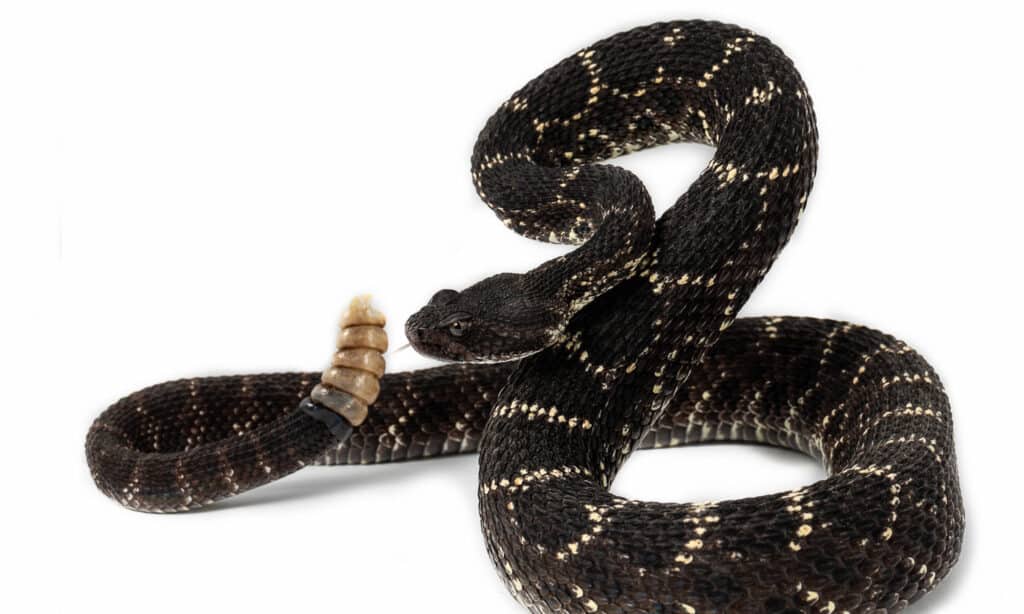
Some scientists believe that rattlesnakes’ rattles were developed as a response to the threat from bison.
©Scott Delony/Shutterstock.com
Population and Conservation Status
The National Parks Service completed a survey from 2003 to 2005 and determined that the species is relatively rare. Unfortunately, the species’ rarity made it impossible to collect enough information to estimate their population. However, the New Mexico Department of Game & Fish listed them as a “Species of Greatest Conservation Need (SGCN)” in the State Wildlife Action Plan for New Mexico (NMDGF 2016).
The IUCN has not assessed the Arizona black rattlesnake for inclusion in the IUCN Redlist.

©Zoomi365/Shutterstock.com
Appearance and Description
The Arizona black rattlesnake is one of 13 rattlesnakes that are present in Arizona. This snake is a medium size, heavy-bodied, and has a spade-shaped head. Juvenile Arizona black rattlesnakes have a base color that is light gray or brown with dark brown to black blotches that are roughly oval to rectangle-shaped running down the length of their backs that can end in bands around the tail. In addition, they have dark lines on the side of their heads, bordered by white or grayish-white, that usually cross over the top of their snout. The lines sweep back diagonally downward, and the dark line continues to the end of their jaw, the effect of which is a masked appearance.
Over time, the snakes darken and become brown or nearly black, making their patterns difficult or impossible to see.
Some Arizona black rattlesnakes have a unique ability: they can rapidly change colors under certain conditions. For example, a nearly black snake becomes a gray snake with a clear pattern in a few minutes, then back to normal when they relax. In addition, captive snakes sometimes lighten after feeding, and stressful events like being captured can trigger a color change.
That’s not the only fascinating thing about their rapid color change! They also appear able to control the color change, and some exhibit darker coloring during the day and lighter at night.

Young Arizona black rattlesnakes have a distinct pattern and dark stripes on the side of their head.
©Evelyn D. Harrison/Shutterstock.com
Venom: How Dangerous is the Arizona Black Rattlesnake?
Like all rattlesnake species, they have a very advanced venom-delivery system. Rattlesnakes have fangs hinged at the base that fold up into their mouths. Like a hypodermic needle, their fangs are hollow and directly attached to venom glands. This structure allows rattlesnakes to grow much larger fangs that inject venom deeply into their victim.
These rattlesnakes are considered moderately venomous, and a bite from one requires immediate medical care. However, they are not aggressive snakes; they are pretty docile. Most bites occur on the hands and feet because someone stepped on or otherwise harassed them.
Behavior and Humans
This species was the first that scientists observed exhibiting social behavior, such as communal parenting, sharing basking locations, and interacting with other snakes of its species. They often nest with other snakes, sharing den space, and the females share parenting duties.
Most interactions with humans and Arizona black rattlesnakes happen when the snake passes through camping areas and across roads or paths. This snake will move along quickly if given the time to do so and doesn’t want to be near people.
Similar Animals
View all 194 animals that start with AArizona Black Rattlesnake FAQs (Frequently Asked Questions)
Are Arizona black rattlesnakes venomous?
Yes, they’re moderately venomous and a bite from one requires immediate medical attention. However, these snakes don’t bite very often.
Where do Arizona black rattlesnakes live?
These snakes live in central Arizona and western New Mexico, at altitudes from 4,000 to 9,000 feet.
Are Arizona black rattlesnakes aggressive?
These are mild-mannered rattlesnakes and not aggressive at all.
What do Arizona black rattlesnakes eat?
Like many snakes, they have a diet rich in small mammals like rats and mice; they also eat lizards and birds.
How do Arizona rattlesnakes hunt?
They’re ambush predators and spend a good portion of their time coiled up under leaf litter, and in crevices in and under rocks.
Thank you for reading! Have some feedback for us? Contact the AZ Animals editorial team.
Sources
- Arizona Black Rattlesnake Bite | DovMed, Available here: https://www.dovemed.com/diseases-conditions/arizona-black-rattlesnake-bite/
- Social Behavior of Arizona Black Rattlesnakes | Snakes.ngo, Available here: https://www.snakes.ngo/arizona-black-rattlesnake-aggregations-exhibit-hallmarks-of-sociality/
- Arizona Black Rattlesnake | Mark Allen Davis, Available here: https://www.researchgate.net/publication/306392551_Rattlesnakes_of_Arizona_-_Arizona_Black_Rattlesnake_Crotalus_cerberus_Coues_1875
- Reptile Database, Available here: https://reptile-database.reptarium.cz/species?genus=Crotalus&species=cerberus
- Advocates for Snake Preservation, Available here: https://www.snakes.ngo/wp-content/uploads/2021/07/Buzz-07.pdf

















